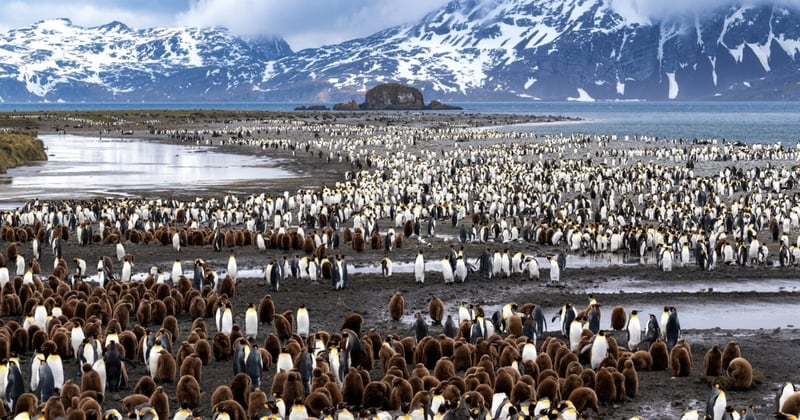
5 Tips for Wildlife-Friendly Travel
News
We invited Jarryd and Alesha of NOMADasaurus – Australia’s biggest adventure travel blog - to share with you their tips for protecting animals on holiday.
Words and images by Alesha and Jarryd of NOMADasaurus
From the elephants of the Okavango to the orangutans of Borneo, our planet is filled with a stunningly diverse abundance of beautiful and fascinating creatures. And with so many animals out there, it’s little wonder that travelling to have remarkable wildlife encounters is an experience that millions of people want to do every year.
To ensure that our animal friends stay safe and healthy for many generations to come, it’s important to make sure we treat wildlife with respect and only take part in responsible attractions and activities.
To help with that, we’ve put together our top 5 tips for wildlife-friendly travel. By following these general guidelines and remembering to always put the welfare of the animals first, you will be consciously making a stand against animal abuse and unethical practices.
Let’s begin!
Observe Wildlife in the Wild
There is no greater thrill or privilege than seeing some of the world’s most remarkable animals out in their natural habitat.
While there are many wildlife sanctuaries around the world that do offer a chance to get close to a variety of species in a responsible manner, it doesn’t compare to happening upon something as beautiful as an elephant or snow leopard in the wild.
If you’re travelling with a goal of seeing a particular animal, try to structure your trip around an authentic experience in the wild. If you do find that elusive creature, even from afar, it’s a memory that will mean so much more to you for years to come.
Wild dolphins off the Galapagos islands (credit: NOMADasaurus)
Avoid Animal Performances and Unethical Attractions
As tempting as it may be to ride an elephant, cuddle a baby tiger or see dolphins perform tricks, the cruel practices that happen behind the scenes are extremely harmful to the health and wellbeing of these animals.
Almost all forms of entertainment performed by animals is unnatural, curated by humans through various methods of sometimes vicious training regimes.
The best way to commit to wildlife-friendly travel is to avoid any places that use animals for the purpose of entertainment.
Do Your Research Before Booking an Experience
When it comes to businesses that run wildlife experiences, not all companies are created equal. While there are many that commit to doing the right thing with a focus on conservation and positive animal welfare, there are some that treat animals as a money-making scheme.
In order to make sure you don’t accidentally commit to a tour that might not be the most responsible, do your research before signing up. Read online reviews, check out blogs from people who have done the same thing, and if in doubt reach out to the company directly or organisations like World Animal Protection to see what they have to say about it.
It’s not just about researching companies either. If you’re unsure about any activities that involve animals, jump on the Internet and find out as much information as you can.
One example is swimming with whale sharks in Cebu, Philippines. While these beautiful sharks are free, they are baited by tour operators to stay around the bay, are often struck by boat propellors, and become stressed by far too many people getting close them. Initial reviews usually say the experience is amazing, but further research unveils the truth. Don’t settle for the first thing you read if you’re not 100% positive on something.
Do Not Buy Any Souvenirs Containing Animal Products
We all want to come home from our holidays with fantastic souvenirs and gifts to share with our friends and family. But it’s important to make sure that whatever items we do end up buying when on vacation doesn’t put local wildlife in danger.
Material like fur, ivory and exotic leather may contribute to poaching or unethical farming, and may put endangered animals at further risk.
You can do your part to help protect our animal friends around the world by not buying any products that are made from animals.
Grizzly bear at Chilkoot Lake, Alaska (credit: NOMADasaurus)
Spread the Word
The best way you can inspire people to experience animals in an ethical and natural environment is to share your own experiences and tips with them.
If you have visited a particularly amazing sanctuary, tell your friends and family about it so they might consider visiting on their next vacation. Alongside that, if you know of an activity or attraction that is harmful, don’t be afraid to share that information with everyone you know.
The vast majority of people would not knowingly do something that would hurt an animal, and if they receive the education before they ride that elephant or take a selfie with a tiger, there’s a high likelihood that they would choose not to go ahead with it.
Next time you’re planning your wildlife travels, make sure you follow the tips above and you’ll ensure your experience is positive for both yourself and the animals you meet along the way.
Header image: King penguins at Salisbury Plains, Antarctica (credit: NOMADasaurus)
Next time you’re planning your wildlife travels, make sure you follow these tips and you’ll ensure your experience is positive for both yourself and the animals you meet along the way.

